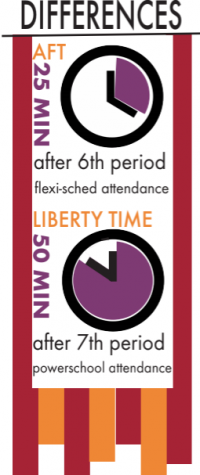Academic Support: Liberty Time vs AFT
The Live Wire explores how new adjustments to academic hours, including the addition of Liberty Time, affect students and staff.
November 9, 2018
Sixth period is over, but no one stirs except for the occasional cough or sniffle. Pencils keep writing, keys continue clicking, and soft murmurs spread throughout the room. With twenty-five minutes until seventh period, students hurry to finish their homework or do some last minute studying. This becomes routine each day of the week except for Thursday when seventh period proceeds directly after sixth to compensate for a shortened school day. This time is supposed to be dedicated for make up work and extra teacher assistance.
Advance one year later and that has all changed. Now on Monday and Friday students sit through almost hour-long class periods, whereas classes throughout the middle of the week fly by due to a shortened schedule to allow an hour for the new Liberty Time. There’s enough time to take tests, makeup labs, and finish most homework.
Academic Focus Time was introduced last year as a twenty- five minute time period of work time everyday after sixth period except for Thursdays.
This year, Liberty’s staff and administration worked with the Instructional Leadership Team, ILT, and decided to transition into a new system titled ‘Liberty Time’. It is held two days a week, Tuesday and Wednesday, for fifty-five minutes to conserve instructional time for teachers.
“There [were] a lot of really good things happening obviously, but we knew we could do better. We felt that this was an area where we could make some adjustments, which were smart based on data, that would improve the experience and achievement of students,” said Brady Shutt, Social Studies teacher and member of the ILT. “The vision at Liberty [was] that people [could] collaborate really effectively together, and now they have time to do that.”
Last year the ILT, made up of teachers, counselors, staff and administration, met every Wednesday to discuss the development of the school.
As the year progressed, data from grades, attendance, and feedback found AFT to be ineffective in not providing enough time to finish work and meet with teachers. This caused many students to not do any school work and instead be on their phones or socialize. With these complications in mind they started brainstorming possible changes.
“As we were talking about AFT last year, we weren’t very satisfied with how it was going,” said Principal Scott Kibby. “We did it the way we did because we had some teachers we were sharing with West High and we wanted to align our day with [them]. So we just copied what they did. Now we got to live with it a year and decide if this is what we want to do.”
During the summer, Kibby attended the Multi-Tiered Systems of Support Conference, where advanced sessions were held for school psychologists and other educational professionals interested in improving the needs of their schools.
While at the conference, Kibby met with the principal of Clear Creek Amana and discussed their schools’ homerooms.
After the meeting among assistant principals Justin Colbert and Emily O’Donnell, the principal of CCA, and Kibby, the ILT formulated Liberty Time and ran it by Matt Degner, the assistant superintendent of the ICCSD.
Instead of simply assigning homerooms based off of last names, Kibby went through and hand-picked the students in each Liberty Time based off of a few factors.
“Every Liberty Time kid is in a class with a teacher they have already,” said Kibby. “My goal is for them to have a relationship with that staff member. The second piece is that I have tried to spread the grade levels across as well. … I thought maybe on a chance some of those [older students] could help the [younger students] and they’re sitting in the room together already. That was a way for older kids to support younger kids.”
In attempts to support students who are struggling, the National Honor Society is offering tutoring each trimester. Members signed up to tutor for different subjects and interested students will be able to receive help when needed.
Another way teachers are utilizing the full hour is through teacher supervised group study sessions before a test or quiz.
Since every teacher has a Liberty Time, they are available to students for the whole hour.
“If you’re in study hall, most times you don’t have access to your teachers since your teachers are working unless you luck out,” said Mr. Kibby. “With Liberty Time nobody is teaching so everybody has access to all their teachers during that time.”

One of the main issues with last years AFT was the short time period. With AFT being twenty-five minutes long, it only
provided enough time for teachers to meet with a few students. In addition, there was insufficient time to take tests or makeup any required science labs.
“Last year with AFT, by the time you took attendance and settled down it was almost time to go,” said science teacher Nate Oswald. “Now I have time to go around to talk to kids and it’s nice, I don’t feel rushed.”
A survey done of 180 sophomores, juniors, and seniors who attended Liberty last year, found that most preferred Liberty Time to AFT because they felt it benefited them academically.
Many mentioned it was not worth it to get out their homework or try and make up work during AFT since it was such a brief time period.
With Liberty Time being fifty minutes long, students now have more time to finish homework assignments, ask questions to teachers, make up labs, and review missed material. As many students are involved in time-consuming extracurricular activities, finishing homework at school can prove beneficial in a few ways.
“[Liberty Time has] given me a good chunk of time where I can just focus, get a lot of my
homework done and talk to teachers if I need to,” said Caleb Schillinger, sophomore. “It gives me a lot more free time after [cross country] so I can get to bed earlier and do other things.”
Another benefit to Liberty Time is that it provides a study hall for students who do not have the room to fit one in their schedule. It is a good amount of time to complete any assigned homework and ask teachers for additional help.
“Students I asked said Liberty Time is beneficial to them because a lot of them have a full schedule and had always wanted to have a study hall but couldn’t fit it in. They appreciated having a big block of time in school they can use to do work, get their homework done and go to teachers to make up tests,” said Shutt.
Although Liberty Time is mainly preserved for students academic learning, the ILT is allowing a new change in hopes of furthering Liberty’s core value of belonging.
The first and third Wednesday of the month are on a club rotation allowing clubs to meet during school hours in hopes to allow more students to get involved and feel they belong at Liberty. An incentive was also put in place for juniors and seniors who have 7th open. If the students are in good academic standing (no D’s or F’s) they are allowed to opt out of Liberty Time with parental approval.
Though Liberty Time seems to thus far be benefiting Liberty students, data and time will tell how it will affect the students academically in the long run.






